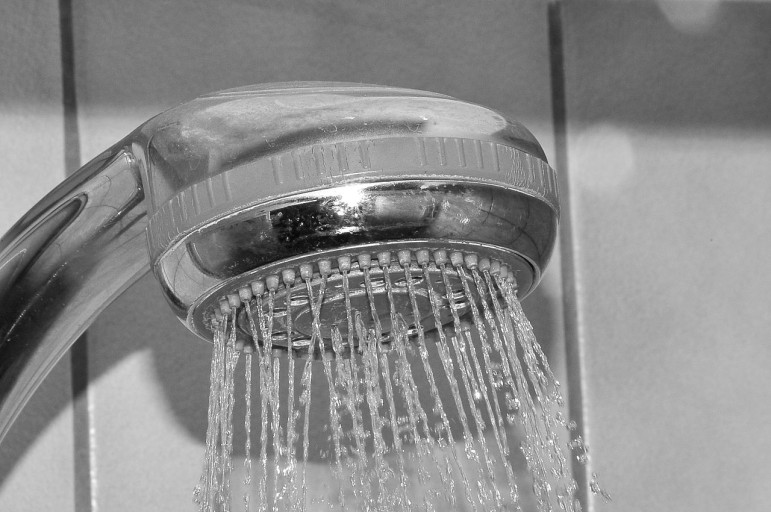
Nicole-Koehler
There are ways to reduce the water impact of your shower, like low-flow shower heads.
It might not seem that way the next time a sudden storm washes out your ballgame or threatens your new leather shoes, but the large amount of rain New York City gets is a blessing: It’s a big reason why we don’t face, and likely will never face, a water emergency of the sort plaguing California right now. Wise decisions made decades ago by city planners—to seek an upstate water supply, for instance—and brilliant engineering (like getting 95 percent of New York City’s water delivered by gravity) also increase New York’s water security. Meanwhile, on the demand side, New York consumes about a third less water than it did 25 years ago even though its population is significantly larger.
More conservation would be helpful now, as the city tries to reduce sewer overflows and other problems associated with the discharge of water after New Yorkers are done using it. And in seven years’ time, additional conservation will be necessary to reduce strain on the water system when the Delaware Aqueduct, which currently provides about half our water, goes out of service for eight months to permit repairs to a massive leak.
Much of the progress in conserving water was accomplished by the installation of low-flow toilets in the 1990s. But there are additional ways you can reduce your own water footprint, and save money:
In the kitchen:
If you use a dishwasher, only run it full, and if you’re buying a new dishwasher, look for one that offers water efficiency. Don’t run the faucet while doing dishes by hand. Instead, fill a basin with hot, soapy water and turn the tap off. Scrub everything. Then turn the water on to rinse. You can put the used soapy water in your toilet tank to use it again.
At the bathroom sink:
Don’t run the water when you’re brushing your teeth, shaving or daydreaming. But by all means keep daydreaming—and bushing your teeth. Also, fix drips and leaks. Most faucet leaks are caused by a faulty washer or a worn-out O-ring that’s supposed to seal a valve. Shut of the water under the sink, unscrew the faucet handle and take a look at some of the tiny rubber items inside. Your hardware store will sell tiny packets of replacement parts. If you’re a renter, this is a step you should ask the super to take. But if he’s slow and you care about saving water, it’s not rocket science to do it yourself.
In the shower:
A shorter shower helps no matter what. You can try taking a “basic training shower” and get it done under 3 minutes. If you’re really serious about it, you can wet down, shut the water off, do the soap and shampoo bit, then turn the water back on to rinse off. Installing a low-flow shower head, however, means more efficient water delivery regardless of how long you lather up for. Standard heads use 5 to 8 gallons a minute but low-flow heads typically deliver 2.5 gallons per minute. There are even versions that cut usage down to 1.6 gallons per minute. And when giving or taking baths, only fill the tub halfway. Don’t worry, your rubber ducky will still float—I’ve checked.
At the toilet:
Flushing less is a no-brainer; you can always let it mellow if … well, you know. But as in the shower, plumbing fixtures can make each flush less costly. You can find out how much water your toilet uses by looking between the seat and the tank, where there should be a stamp, or under the lid of the tank. Low-flow toilets use 1.6 gallons per flush. Newer, high-efficiency toilets use 1.28 gallons, or as little as 1.1 gallons. The city is in the midst of a Toilet Replacement Program for which your property might be eligible. But you can make your own by placing a large, heavy object (a brick or two, or a 2-liter soda bottle filled with water) in your toilet tank. This will displace a lot of water, causing the toilet to fill less and discharge less. What’s more, toilet leaks are a major water-eater. If you ever hear your toilet making noise between filling and flushing, it likely means the flap inside the tank is not closing properly. You might need a longer flush chain or a new flap. Replacement sets are cheap at the hardware store. Threaten your children with exile if they ever flush Wet Ones or anything other than toilet paper.
Outside:
If you have access to the ground level of a drainpipe, install a water barrel and use that to water your lawn or plants. Go to a local firehouse to get a cap for a fire hydrant before you open it—that cuts the output per minute from 1,000 gallons to 25 or so. (Be careful opening a hydrant though, as that’s some high-pressure water coming out). If you see an open hydrant, call 311.










One thought on “How to Reduce Your Water Footprint”
Great article! NYC DEP is also sponsoring rain barrel giveaways. The next one is on Saturday, July 11 from 9am to noon at PS 109 in Brooklyn and is co-sponsored by Councilman Jumaane Williams and Assemblymember Helene Weinstein. Contact their offices for more info and to register. Nonprofit housing organization NHS of East Flatbush will also be there. In fact, we are all over this! Last Saturday we gave away 200 rain barrels at our Help for Homeowners event in Mill Basin. We will also be at the 7/11 event to assist homeowners who need help with mortgage distress or even foreclosure, info on property and flood insurance, and funding for emergency home repairs. Hope to see some of your readers there! Anyone who can’t make the event but who needs our assistance can call 718-469-4679 or visit http://www.nhsofeastflatbush.org.